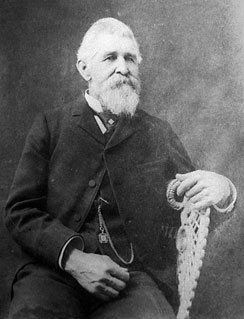Early in the history of the county public attention was directed to the place [Cayucos] on account of its facilities as a port, and some effort was made to build up a suitable landing; but it was not until the advent of
CAPT. JAMES CASS
 that permanent improvements began to be effected.
that permanent improvements began to be effected.
Captain Cass is one of the thorough-going business men who make their mark in any country fortunate enough to secure them as residents. He is of English birth, now in the fifty-eighth year of his age, and as a sea-faring man in his early years has seen much of the world. California has been his home since July 8, 1849, he residing some years in Sacramento County, as merchant and miner in that region. In 1867 the opportunity of business at Cayucos Landing brought him to San Luis Obispo. There he engaged in trade and in landing and shipping merchandise and the products of the country. Cayucos is a Spanish word, equivalent to canoe, or light boat, and many years ago boats made of skins were then used in visiting the vessels that came into the harbor, hence the name applied to the rancho and the town. Captain Cass engaged in lightering, but improved on the skin boats of the Spaniards and natives. The hardships and dangers of such business were numerous, he suffering many a douche of salt water in his combat with the surf. He soon saw the necessity of a wharf, and believed in the practicability of its construction.
CASS’ WHARF.
Through his enterprise and exertions the commodious wharf and warehouse at Cayucos have been built, a view of which is given in these pages. The artist has vividly pictured the scene with its active business and grand surroundings.
Business at Cayucos is concentrated within a very small space which consequently assumes a bustling aspect. Teams stand awaiting their loads of lumber or merchandise or have been disburdened of their customary lading of butter and cheese. The store in the main building is thronged with the substantial and liberal business men and agriculturists of the neighborhood. It is “steamer day,” and the staunch Los Angeles is approaching the extremity of the wharf to receive the accumulated freight which awaits her. Altogether the scene is one of unusual activity and business-like energy. Such is Cayucos Landing.
What there is in Cayucos and whatever there may be in the immediate future is due almost solely to Captain Cass. Others there are whose position or enterprise deserves due credit, but these are in some degree subordinate to Mr. Cass.
In 1875, Cayucos was composed of Captain Cass’ store, warehouse, private dwelling, and a wharf; in the distance stood a ranch house, these buildings comprising all of the visible town. The wharf was but 380 feet long, and afforded imperfect facilities for commerce. Within fifteen months after there had been a complete transformation in affairs. Captain Cass had entered into partnership with several influential gentlemen of the county—Wm. L. Beebee, John Harford, and L. Schwartz—and completely metamorphosed affairs at Cayucos.
Source: History of San Luis Obispo County, California, pp341-342. Transcribed for the CAGenWeb Project by Cathy Portz.
J. H. CRENSHAW
The junior proprietor of the Mirror is Mr. James Henry Crenshaw, who was born November 2, 1854, in Normandy, Bedford County, Tennessee. His parents were John William and Lemira Ellen Crenshaw (nee Campbell), who were married in Fayetteville, Kentucky in 1853. When Mr. Crenshaw was but seven years of age, there came the secession of the Southern States and the great War of the Rebellion followed. His father being an adherent of the Southern cause, joined the Confederate army under Gen. Sterling Price, and died the death of a soldier on the field of battle. His mother survived to guide his youthful footsteps and place him in the self-reliant course of man’s estate to which she had the satisfaction of seeing him safely reach ere her death, which occurred at Paris, Texas, in August, 1880.
Mr. Crenshaw received a good education at the schools of his native village and at the Hume College in Nashville, Tennessee. After leaving school, he took up the path of his future life, entering in 1869, as an apprentice, the office of the Athens, Alabama, Post, remaining there four years, and becoming thoroughly master of the trade of a printer in all its branches. After completing his apprenticeship he worked as a journeyman printer, and in this business visited almost all the Southern and South western States and Territories. The far West at last appeared the most attractive field, and to the Pacific Coast he came. His earliest enterprise as a publisher was in the publication of the Paradise Reporter, at Paradise, Humboldt County, Nevada. The Reporter was a sprightly, well-printed paper, claiming to be Independent but Democratic in its tendencies. Mr. Crenshaw’s associates in that paper were Mr. H. Warren, formerly of Bakersfield, California, and Mr. J. J. Hill, also publisher of the Silver State, at Winnemucca, Nevada. The Reporter was first issued May 10, 1879, and continued until after the election in November, 1880, Mr. Crenshaw at that time being sole proprietor.
If Mr. Crenshaw did not win a fortune in Paradise, he did better by winning a wife, having married Miss Emma Blake at Queen City, Humboldt County, Nevada, December 23, 1880, who continues to make his home happy in San Luis Obispo.
He is a member of the Independent Order of Odd Fellows, and of the Ancient Order of United Workmen, and, it is not necessary to say, of the Democratic Party. In November, 1880, he became an equal partner in the publication of the Mirror, in which business he deems himself settled for life, with bright prospects for a prosperous future.
Source: History of San Luis Obispo County, California, p-280281. Transcribed for the CAGenWeb Project by Cathy Portz.

